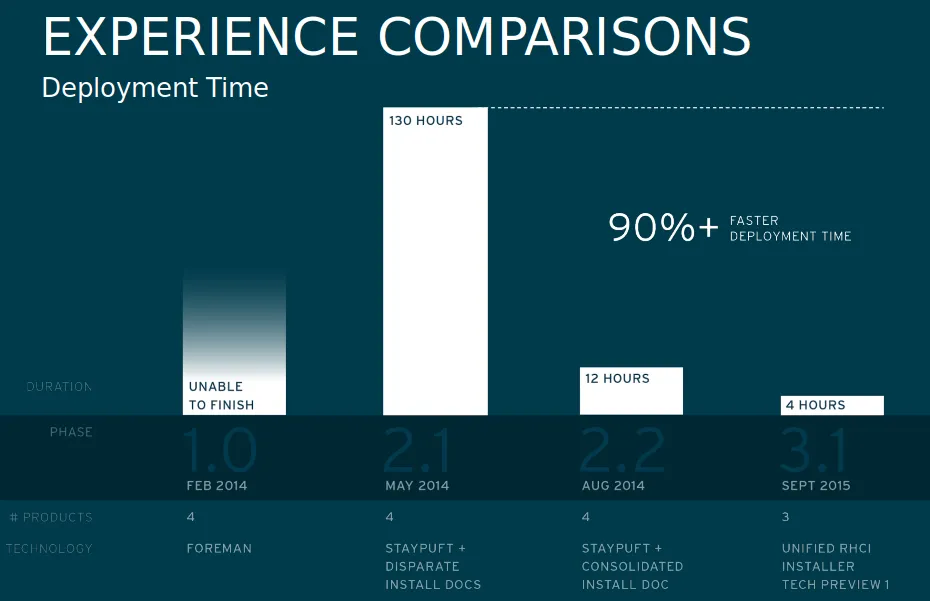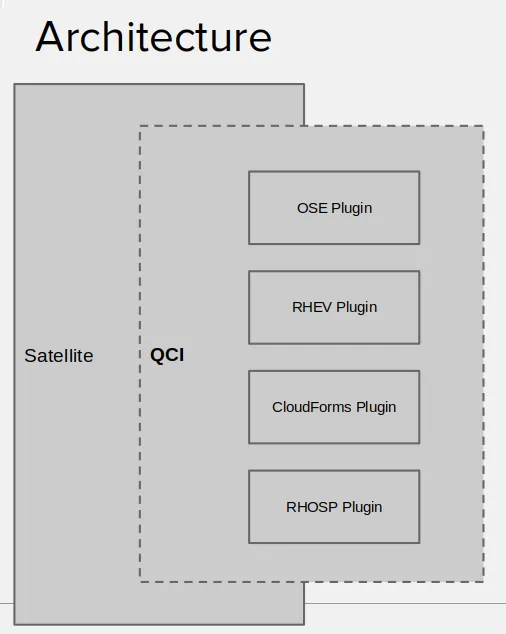What if I told you that you can have your Red Hat Enterprise Linux (RHEL) based Cloud infrastructure, with Red Hat Virtualization, OpenStack, OpenShift and CloudForms all setup before you have to stop for lunch?
Would you be surprised?
Could you do that today?
In most cases I am betting your answer would be not possible, not even on your best day. Not to worry, the solution is here and it's called the QuickStart Cloud Installer (QCI).
Today Red Hat announced the general availability of
QCI 1.0. It's a good time to take a closer look at where this Cloud tool came from, how it evolved and where it is headed.
Born from Need
As products like Red Hat Cloud Suite emerge onto the technology scene, it exemplifies the need for companies to be able to support infrastructure and application development use cases such as the following:
- Optimize IT
- Accelerate Service Delivery
- Modernize Development and Operations
- Scalable Infrastructure
The problem is how to streamline the setup of such intricate solutions?
It started with researching in 2013 how the product Red Hat Cloud Infrastructure (RHCI) was being deployed by Red Hat customers. That information was used to start an effort creating several simple, reproducible installation guides that could cut down the time needed to install the following products:
 Figure 2. Getting the installation of complex infrastructure solutions down from a month, to days, to just hours based on testing by Red Hat.
Figure 2. Getting the installation of complex infrastructure solutions down from a month, to days, to just hours based on testing by Red Hat.
The final product installation documentation brought the deployment time for this infrastructure solution down to just several days, instead of a month. Figure 2 shows the progress made between the efforts of installing RHCI.
The next evolution included Satellite and OpenShift offerings that you now find in the Red Hat Cloud Suite solution. This brought more complexity into the installation process and a push was made to go beyond just documentation. An installation effort commenced that had to bring together all the products, deal with their configurations and manage it all to a full deployment in a faster time frame than several days.
How it Works
The QCI progressed and expanded by functioning as an extension (plugin) of Satellite with intentional roadmap alignment. It uses specific product plugins that interface with their individual APIs so that they can be used for both individual product installations and complete solution base installs.
Figure 1 shows you the architectural layout of QCI as it relates to Satellite. See the online documentation for the versions supported by QCI at the time of this writing, we expect to update the documentation on a regular basis as products are released that QCI supports.
The installer, when first started, spins up the Fusor Installer. This is a plugin to Foreman and is used to perform the initial setup such as networking and provisioning within Satellite to be used later in the deployment.
Some of the deployment steps depend on the path you have chosen when specifying the products you wish to install, for example:
- If a RHV with CloudForms deployment is chosen, the QCI calls Puppet modules for configuring and setting up the RHV environment. It installs RHV-M and runs Python scripts which will set the RHV Datacenter up.
- CloudForms management engine is deployed as a Satellite resource and as such can be launched on top of RHV.
- Most of the OpenShift product deployment uses Ansible to facilitate the installation and setup of the environment.
- OpenStack uses what is known as the TripleO installation. This means OpenStack installed on OpenStack (hence the three O's). It uses an all-in-one ISO image containing OpenStack which then deploys a customized version configured through QCI user interface.
The two deployment patterns supported by QCI are:
- Red Hat Cloud Infrastructure
- Satellite, RHV, OpenStack and CloudForms
- Red Hat Cloud Suite
- Satellite, RHV, OpenStack, CloudForms and OpenShift product
Now here is the unbelievable part we suggested in the title, that both deployment patterns can be installed in under four hours.
 Figure 3. The timeline from pushing the deploy button to completion of your RHEl-based Cloud infrastructure.
Figure 3. The timeline from pushing the deploy button to completion of your RHEl-based Cloud infrastructure.
Yes, you can arrive in the morning to work and have your OpenStack Cloud infrastructure setup by the time you have to break for lunch!
Figure 3 shows you a condensed timeline of our testing of the RHCI installation as an example, but the same is possible with Red Hat Cloud Suite.
The Future is Bright
There is nothing brighter for you than a future where you can reduce deployment times for your Cloud infrastructure, but there is more positive points to take note of when you leverage QCI:
- Simple fully integrated deployments of RHCI and Red Hat Cloud Suite requiring only minimal documentation.
- Easy to use, single graphical web-based user interface for deploying all products.
- Leverages existing Red Hat Storage (Ceph and Gluster) deployments for Red Hat Virtualization, Red Hat OpenStack, and OpenShift product installations.
- Integrated with Red Hat’s Customer Portal for automated subscription management.
- Avoides the need for costly consultants when deploying proof-of-concept environments.
(This article written together with Red Hat Software Engineer Nenad Peric)
See more by Eric D. Schabell, contact him on Twitter for comments or visit his home site.
Sull'autore
Altri risultati simili a questo
Data-driven automation with Red Hat Ansible Automation Platform
Ford's keyless strategy for managing 200+ Red Hat OpenShift clusters
Technically Speaking | Platform engineering for AI agents
Technically Speaking | Driving healthcare discoveries with AI
Ricerca per canale
Automazione
Novità sull'automazione IT di tecnologie, team e ambienti
Intelligenza artificiale
Aggiornamenti sulle piattaforme che consentono alle aziende di eseguire carichi di lavoro IA ovunque
Hybrid cloud open source
Scopri come affrontare il futuro in modo più agile grazie al cloud ibrido
Sicurezza
Le ultime novità sulle nostre soluzioni per ridurre i rischi nelle tecnologie e negli ambienti
Edge computing
Aggiornamenti sulle piattaforme che semplificano l'operatività edge
Infrastruttura
Le ultime novità sulla piattaforma Linux aziendale leader a livello mondiale
Applicazioni
Approfondimenti sulle nostre soluzioni alle sfide applicative più difficili
Virtualizzazione
Il futuro della virtualizzazione negli ambienti aziendali per i carichi di lavoro on premise o nel cloud

